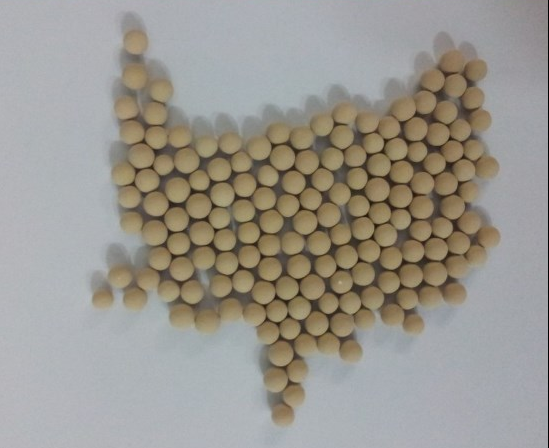产品:3A molecular sieve spherical
Detailed
Type: spherical (particle size 1.8mm-2.5mm, 3.5mm-4.0mm)
Aperture: 3A: 0.3nm; 4A: 0.4nm; 5A: 0.5nm
Introduction to Molecular Sieve
Molecular sieve is a kind of aluminosilicate compound with cubic crystal lattice. Molecular sieve has a uniform microporous structure, and its pores have uniform diameters. These pores can adsorb molecules smaller than their diameter into the inside of the cavities, and have preferential adsorption capacity for polar molecules and unsaturated molecules. The degree of sex is different, the degree of saturation is different, the molecules of different molecular size and boiling point are separated, that is, they have the function of "sieving" molecules, so they are called molecular sieves. Because molecular sieves have high adsorption capacity, strong thermal stability and other advantages that other adsorbents do not have, molecular sieves have been widely used.
Performance
Molecular sieve is powdery crystal with metallic luster, hardness of 3~5, relative density of 2~2.8, natural zeolite has color, synthetic zeolite is white, insoluble in water, thermal stability and acid resistance increase with SiO2/Al2O3 composition ratio Increase and improve. Molecular sieves have a large specific surface area of 300~1000m2/g. The inner crystal surface is highly polarized. It is a kind of high-efficiency adsorbent and a kind of solid acid. The surface has a high acid concentration and acid strength, which can cause normal carbon. Ionic catalytic reaction. When the metal ions in the composition are exchanged with other ions in the solution, the pore size can be adjusted to change its adsorption properties and catalytic properties, thereby preparing molecular sieve catalysts with different properties.
Structure
The resulting proteoglycan polymer twists and turns to form a microporous sieve structure called molecular sieve. Molecular sieves only allow substances smaller than their micropores to pass through, and have a barrier effect on macromolecular substances and bacteria larger than their micropores. Make the matrix a defensive barrier to limit the spread of harmful substances such as bacteria. Streptococcus hemolyticus and cancer cells can produce hyaluronidase, break down proteoglycans, destroy the matrix structure, and spread. The proteoglycan polymer is also combined with many hydrophilic groups, which can bind a large number of water molecules to form an extracellular "reservoir".
Features
Molecular sieve has a strong moisture absorption capacity (so it is widely used as a desiccant) and is used for gas purification. Avoid direct exposure to the air during storage. Molecular sieves that have been stored for a long time and have absorbed moisture should be regenerated before use. Molecular sieve avoids oil and liquid water. Try to avoid contact with oil and liquid water when in use. The gases to be dried in industrial production include air, hydrogen, oxygen, nitrogen, argon, etc. Two adsorption dryers are used in parallel, one works, and the other can be regenerated. Alternate work and regeneration to ensure continuous operation of the equipment. The dryer works at 8-12°C, and regenerates when heated to 350°C. Different specifications of molecular sieve have slightly different regeneration temperatures. Molecular sieves have a good catalytic effect on certain organic gas phase reactions.
Kind
There are two types of molecular sieves: natural zeolite and synthetic zeolite. ① Most natural zeolites are formed by the reaction of volcanic tuff and tuffaceous sedimentary rocks in marine or lacustrine environments. At present, more than 1,000 kinds of zeolite minerals have been discovered, of which 35 are more important. The common ones are clinoptilolite, mordenite, erionite and chabazite. Mainly distributed in the United States, Japan, France and other countries, China has also discovered a large number of mordenite and clinoptilolite deposits. Japan is the country with the largest amount of natural zeolite mining. ②Since natural zeolite is restricted by resources, a large number of synthetic zeolites have been used since the 1950s. Commercial molecular sieves often use prefix numbers to classify molecular sieves with different crystal structures, such as type 3A, type 4A, and type 5A. Type 4A is type A in the table, with a pore size of 4Å;. A type molecular sieve containing Na+ is denoted as Na-A. If Na+ is replaced by K+, the pore size is about 3Å; that is 3A type molecular sieve. 5Å;, that is, 5A molecular sieve.
Drying technology
Microwave drying technology solves the problems of slow drying speed, large energy loss and poor product quality in traditional drying molecular sieves. The specific manifestations are:
1. The microwave drying molecular sieve is fast, and the purpose of microwave drying can be achieved in a few minutes;
2. Microwave drying molecular sieve is uniform, achieving deep drying and good product quality;
3. Static drying, no burning belt, less dust;
4. Non-contact drying avoids the pollution of molecular sieve;
5. The microwave drying molecular sieve process is safe, energy-saving, and environmentally friendly. The use of electric energy, drying both inside and outside, saves more than 50% of energy than electric drying;
6. Shorten the production cycle and greatly reduce the occupation of production working capital;
7. The cabinet temperature of the microwave drying equipment is below 40℃, which improves the working environment of workers;
8. The equipment is simple and convenient to operate.
| Warm tip: the products supplied by Beijing Beike Xincai Technology Co., Ltd. are only used for scientific research, not for human body |
| Item ID | Info |
| BK2020110702-01 | CAS: ID:BK2020110702 Pack:500g Parameter:3A分子筛圆球形 Stock:100 Make up: Price:$30 |
| BK2020110702-02 | CAS: ID:BK2020110702 Pack:1kg Parameter:3A分子筛圆球形 Stock:100 Make up: Price:$50 |
| BK2020110702-03 | CAS: ID:BK2020110702 Pack:2kg Parameter:3A分子筛圆球形 Stock:100 Make up: Price:$88 |
- Previous: Beta molecular sieve s
- Next: MCM22 molecular sieve


 Molecular sieve
Molecular sieve
